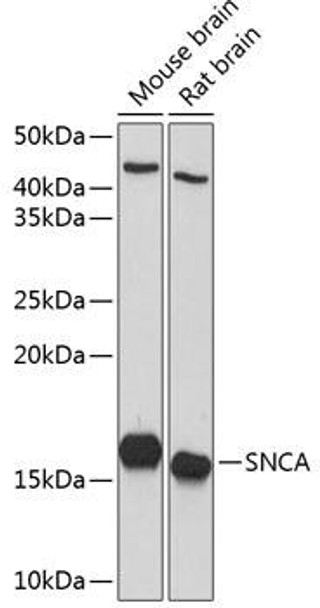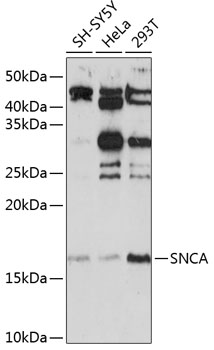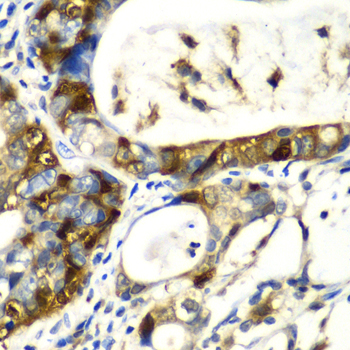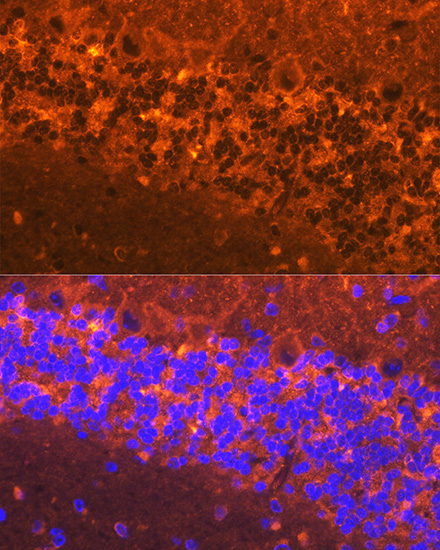Description
Anti-SNCA Antibody (CAB13354)
The SNCA Polyclonal Antibody (CAB13354) is a powerful tool for researchers studying the SNCA protein, which is associated with various neurodegenerative disorders, including Parkinson's disease. This antibody, produced in rabbits, exhibits high specificity and sensitivity when detecting SNCA in human samples, making it an ideal choice for Western blotting applications.SNCA, also known as alpha-synuclein, is a key player in the pathogenesis of Parkinson's disease and other synucleinopathies. By binding to SNCA, this polyclonal antibody enables researchers to visualize and quantify the protein in different cell types, providing insights into its role in disease progression and potential therapeutic targets.
With its ability to accurately detect SNCA in biological samples, the SNCA Polyclonal Antibody (CAB13354) is essential for studies aimed at understanding the mechanisms underlying neurodegenerative diseases and developing novel treatment strategies. Researchers in the fields of neuroscience and neurology will benefit greatly from using this antibody in their investigations.
| Antibody Name: | Anti-SNCA Antibody |
| Antibody SKU: | CAB13354 |
| Antibody Size: | 20uL, 50uL, 100uL |
| Application: | WB IHC IF |
| Reactivity: | Human, Mouse, Rat |
| Host Species: | Rabbit |
| Immunogen: | Recombinant fusion protein containing a sequence corresponding to amino acids 61-140 of human SNCA (NP_000336.1). |
| Application: | WB IHC IF |
| Recommended Dilution: | WB 1:500 - 1:2000 IHC 1:50 - 1:200 IF 1:50 - 1:200 |
| Reactivity: | Human, Mouse, Rat |
| Positive Samples: | SH-SY5Y, HeLa, 293T, Mouse brain, Rat brain |
| Immunogen: | Recombinant fusion protein containing a sequence corresponding to amino acids 61-140 of human SNCA (NP_000336.1). |
| Purification Method: | Affinity purification |
| Storage Buffer: | Store at -20'C. Avoid freeze / thaw cycles. Buffer: PBS with 0.02% sodium azide, 50% glycerol, pH7.3. |
| Isotype: | IgG |
| Sequence: | EQVT NVGG AVVT GVTA VAQK TVEG AGSI AAAT GFVK KDQL GKNE EGAP QEGI LEDM PVDP DNEA YEMP SEEG YQDY EPEA |
| Gene ID: | 6622 |
| Uniprot: | P37840 |
| Cellular Location: | Cell junction, Cytoplasm, Membrane, Nucleus, Secreted, cytosol, synapse |
| Calculated MW: | 11kDa/13kDa/14kDa |
| Observed MW: | 18KDa |
| Synonyms: | PD1, NACP, PARK1, PARK4, SNCA |
| Background: | Alpha-synuclein is a member of the synuclein family, which also includes beta- and gamma-synuclein. Synucleins are abundantly expressed in the brain and alpha- and beta-synuclein inhibit phospholipase D2 selectively. SNCA may serve to integrate presynaptic signaling and membrane trafficking. Defects in SNCA have been implicated in the pathogenesis of Parkinson disease. SNCA peptides are a major component of amyloid plaques in the brains of patients with Alzheimer's disease. Alternatively spliced transcripts encoding different isoforms have been identified for this gene. |
| UniProt Protein Function: | SNCA: a member of the synuclein family. Abundantly expressed in the brain. Inhibits phospholipase D2 selectively. May integrate presynaptic signaling and membrane trafficking. Implicated in the pathogenesis of Parkinson's disease. A major component of amyloid plaques in the brains of patients with Alzheimer's disease. Two alternatively spliced isoforms transcripts have been identified. |
| UniProt Protein Details: | Protein type:Adaptor/scaffold Chromosomal Location of Human Ortholog: 4q21 Cellular Component: Golgi apparatus; nuclear outer membrane; mitochondrion; rough endoplasmic reticulum; lysosome; extracellular region; fibril; terminal button; inclusion body; cell cortex; mitochondrial respiratory chain complex I; cytosol; actin cytoskeleton; synaptic vesicle; platelet alpha granule membrane; growth cone; perinuclear region of cytoplasm; axon; cytoplasm; plasma membrane; ribosome; cell junction; nucleus Molecular Function:protein domain specific binding; identical protein binding; histone binding; zinc ion binding; kinesin binding; ferrous iron binding; microtubule binding; caspase inhibitor activity; beta-tubulin binding; magnesium ion binding; phosphoprotein binding; protein N-terminus binding; oxidoreductase activity; Hsp70 protein binding; calcium ion binding; dynein binding; protein binding; copper ion binding; phospholipase binding; phospholipid binding; tau protein binding; fatty acid binding; alpha-tubulin binding Biological Process: regulation of long-term neuronal synaptic plasticity; negative regulation of serotonin uptake; regulation of acyl-CoA biosynthetic process; adult locomotory behavior; positive regulation of apoptosis; negative regulation of norepinephrine uptake; mitochondrial membrane organization and biogenesis; microglial cell activation; response to lipopolysaccharide; positive regulation of endocytosis; dopamine biosynthetic process; negative regulation of transcription from RNA polymerase II promoter; negative regulation of caspase activity; negative regulation of monooxygenase activity; fatty acid metabolic process; positive regulation of neurotransmitter secretion; regulation of dopamine secretion; negative regulation of dopamine uptake; negative regulation of histone acetylation; calcium ion homeostasis; negative regulation of exocytosis; response to magnesium ion; negative regulation of protein amino acid phosphorylation; behavioral response to cocaine; receptor internalization; phospholipid metabolic process; fibril organization and biogenesis; synapse organization and biogenesis; dopamine uptake; negative regulation of neuron apoptosis; response to iron(II) ion; positive regulation of receptor recycling; aging; caspase activation; response to drug; neutral lipid metabolic process; protein destabilization; regulation of macrophage activation; regulation of glutamate secretion; negative regulation of microtubule polymerization; positive regulation of peptidyl-serine phosphorylation; negative regulation of dopamine metabolic process; organelle ATP synthesis coupled electron transport; regulation of locomotion; synaptic vesicle endocytosis; positive regulation of release of sequestered calcium ion into cytosol; regulation of excitatory postsynaptic membrane potential; negative regulation of transporter activity; negative regulation of apoptosis Disease: Parkinson Disease 4, Autosomal Dominant; Dementia, Lewy Body; Parkinson Disease 1, Autosomal Dominant |
| NCBI Summary: | Alpha-synuclein is a member of the synuclein family, which also includes beta- and gamma-synuclein. Synucleins are abundantly expressed in the brain and alpha- and beta-synuclein inhibit phospholipase D2 selectively. SNCA may serve to integrate presynaptic signaling and membrane trafficking. Defects in SNCA have been implicated in the pathogenesis of Parkinson disease. SNCA peptides are a major component of amyloid plaques in the brains of patients with Alzheimer's disease. Four alternatively spliced transcripts encoding two different isoforms have been identified for this gene. [provided by RefSeq, Mar 2009] |
| UniProt Code: | P37840 |
| NCBI GenInfo Identifier: | 586067 |
| NCBI Gene ID: | 6622 |
| NCBI Accession: | P37840.1 |
| UniProt Secondary Accession: | P37840,Q13701, Q4JHI3, Q6IAU6, A8K2A4, |
| UniProt Related Accession: | P37840 |
| Molecular Weight: | 140 |
| NCBI Full Name: | Alpha-synuclein |
| NCBI Synonym Full Names: | synuclein, alpha (non A4 component of amyloid precursor) |
| NCBI Official Symbol: | SNCA |
| NCBI Official Synonym Symbols: | PD1; NACP; PARK1; PARK4 |
| NCBI Protein Information: | alpha-synuclein; synuclein alpha-140; non A-beta component of AD amyloid |
| UniProt Protein Name: | Alpha-synuclein |
| UniProt Synonym Protein Names: | Non-A beta component of AD amyloid; Non-A4 component of amyloid precursor; NACP |
| Protein Family: | Alpha-synuclein |
| UniProt Gene Name: | SNCA |
| UniProt Entry Name: | SYUA_HUMAN |




















